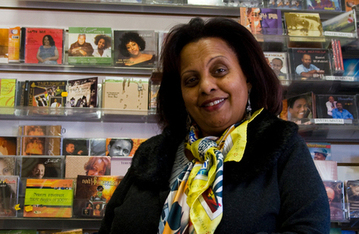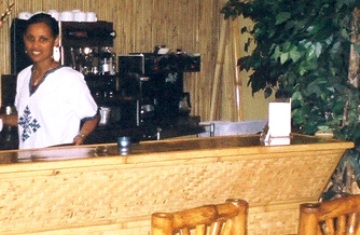
Above: Genet Asrat, owner of Albo African Gift shop in Oakland,
California.
A fragrant shop helps Ethiopians far from home
By ISABEL ESTERMAN
(Oaklandnorth.net)
Posted on 26 November 2008
Inside Oakland’s Albo African Gift shop, at the corner of Alcatraz and Telegraph, a deep herbal aroma wafts from a row of colorful bottles labeled ‘frankincense.’ Ethiopian Singer Hamelmal Abate’s mournful vibrato pours out of the stereo, crooning over an incongruously lively beat, while the store’s owner, Genet Asrat, sits behind the counter, her black sweater brightened by a bold patterned scarf with a yellow border. The phone rings nearly continuously, and Asrat switches back and forth between English and Amharic as she fields calls, raising her precisely-arched eyebrows and flashing a big, quick smile as she taps away at her keyboard.
The store is filled with baskets, scarves, jewelry and clothing in brilliant shades of orange, red, pink and purple. The walls are lined with African-themed carvings and paintings. Customers come in to browse racks of T-shirts and books with African themes. And while T-shirts are the store’s big sellers, the repeat customers, like the young man who stands shyly by the door until Asrat beckons him forward, are immigrants who come to the store to wire money back to their families in Ethiopia, a service Asrat offers at less than half the price Western Union charges.
Businesses like Asrat’s may provide a touch of the exotic to the neighborhood, but for Ethiopian immigrants, they create a familiar space, and serve as a valuable link to their native country. Some of the phone calls, Asrat explains, are from customers looking for help booking flights home. Asrat doesn’t just a keep a shop or send remittances. “I’m also a travel agent,” she says. Many immigrants, she says, “don’t have the know-how” to look for discounted tickets online and are uncomfortable working with an English-speaking agent. “It’s easier for them, and it’s convenient for them to call and buy them from me.”
Meanwhile, Asrat’s old friend Fetlework Tefferi — whose businesses, Café Colucci and Brundo grocery store, are located to either side of Asrat’s shop – works to source spices from businesses in Africa that use organic ingredients and employ women. “I want to help women preserve their culinary heritage,” says Tefferi, an energetic woman who runs between Colucci and Brundo donning and removing a pair of rubber gloves while supervising the cafe’s redecoration, signing forms, and tasting new batches of spices.
Businesses like these make North Oakland a hub for the Bay Area Ethiopian community, even though neither census data nor anecdotal evidence indicates there is a particularly high concentration of Ethiopian immigrants living in the neighborhood. “They live everywhere,” says Tefferi. “They just have their businesses on Telegraph.”

Inside Oakland’s Albo African Gift shop
According to the 2000 census, there are 1,444 foreign-born Ethiopians in Alameda County, and 228 living in north Oakland, although Rebecca Lakew, program director at the Ethiopian Community Center in Oakland, says that number is much too low. Some of the discrepancy may come from how people answer census takers or fill out government forms, Lakew says. “A lot of Ethiopian people, the people who are here as immigrants or refugees, they don’t say they are from there,” she says. “They mark ‘other’ or just ‘black.’”
Along with Washington, D.C., Los Angeles, Seattle, Atlanta and Houston, the Bay Area has one of the largest Ethiopian populations in the United States. Lakew estimates the number of Ethiopians in the Bay Area to be at least 20,000, and says the largest community event, the annual Ethiopian New Year festival, can draw as many as 40,000 people from Oakland, San Francisco and San Jose. “Every year it grows,” she says.
Large waves of Ethiopians began migrating to the United States in the 1980s and 1990s, as the political and economic situation in Ethiopia deteriorated. Marxist dictator Mengistu Haile Mariam overthrew Emperor Haile Selassie in 1974, and was immediately faced with a series of counter-coups, uprisings and border skirmishes. In 1977 – 1978, Mengistu attempted to crush opposition with a massacre known as the “Red Terror,” during which human rights groups estimate as many as 500,000 people were killed, tortured or disappeared by government-sponsored militias.
Mengistu continued to spend heavily on the military, especially to counter rebellions in the country’s north. When a devastating series of droughts and famine hit the country in the 1980s, the government was ill-prepared for the crisis, and nearly 1 million Ethiopians starved to death in 1984 and 1985.
Mengistu was forced to flee the country in 1991, and the first multi-party elections were held in 1993, but problems in Ethiopia continue to push people to emigrate. “There is a lot of corruption, there are no jobs, the standard of education is low,” says Lakew. Many look for opportunities abroad, she says, for the same reasons as emigrants from anywhere in the world. “They have to eat,” she says. “They have to work, they have to support their families.”
The congressionally mandated Diversity Immigrant Visa Program — which provides 55,000 Visas each year to people from countries with low rates of immigration to the United States — has opened up greater possibilities for Ethiopians wishing to immigrate. Nationally, Ethiopians have consistently been among the top groups receiving these visas, topping the list with 3,427 visas in 2005.
Lakew refers to the Diversity Visa program as “fortunate, but unfortunate.” Applicants are required to have either a high school diploma or at least two years experience in a skilled occupation, but many face still face high barriers when they arrive. “It’s the language, the lack of experience, even the cultural difference. They have a culture shock,” says Lakew. “The moment you arrive in the states, you expect everyone to be there for you. And they’re not.”
Newcomers are forced to rely on friends and relatives, and on community agencies like the Ethiopian Community Center, which provides job, housing and heath-care referrals, and works with Laney and Peralta college to get immigrants into English classes and career training.
This disorientation helps to explain why Ethiopian immigrants, no matter where in the Bay Area they live, congregate along Telegraph Avenue. “It’s creating a community in a way,” says Tefferi. “I think immigrants do that as a matter of course. We want to be all in the same neighborhood, so in case something happens, we can all be together, help each other.”
When Sheba Ethiopian restaurant opened on Telegraph in the 1980s, Tefferi says, local Ethiopians started going there to eat, and liked the area. The university, in particular, was a “natural draw,” Tefferi says. “Ethiopians congregate around schools. It’s like prestige, education.”
The diversity of the neighborhood was attractive as well, says Asrat. “It was very open, very international, it was very easy to mix.” So Asrat opened her shop in June 1991, and Tefferi followed, opening Café Colucci about two months later. “It just happened,” both Asrat and Tefferi say. “We congregate,” says Tefferi. “And the competition is not even spoken of as such.”
Tefferi, who lives in San Francisco, says she loves coming to work on Telegraph. “It’s like traveling to Ethiopia–I come here and it’s like I’m home,” she says. “I feel very complete when I’m here. I’m surrounded with the music, the spices, the food. I have the best of both worlds, and I’m always thankful for that.”
—-
Related from Tadias Magazine:
Addis Ethiopian Restaurant: The Best Zilzil Tibs in the Bay



























Best zilzil tibs, ummmm yammmmm
http://www.youtube.com/watch?v=M-MuYa36-sk